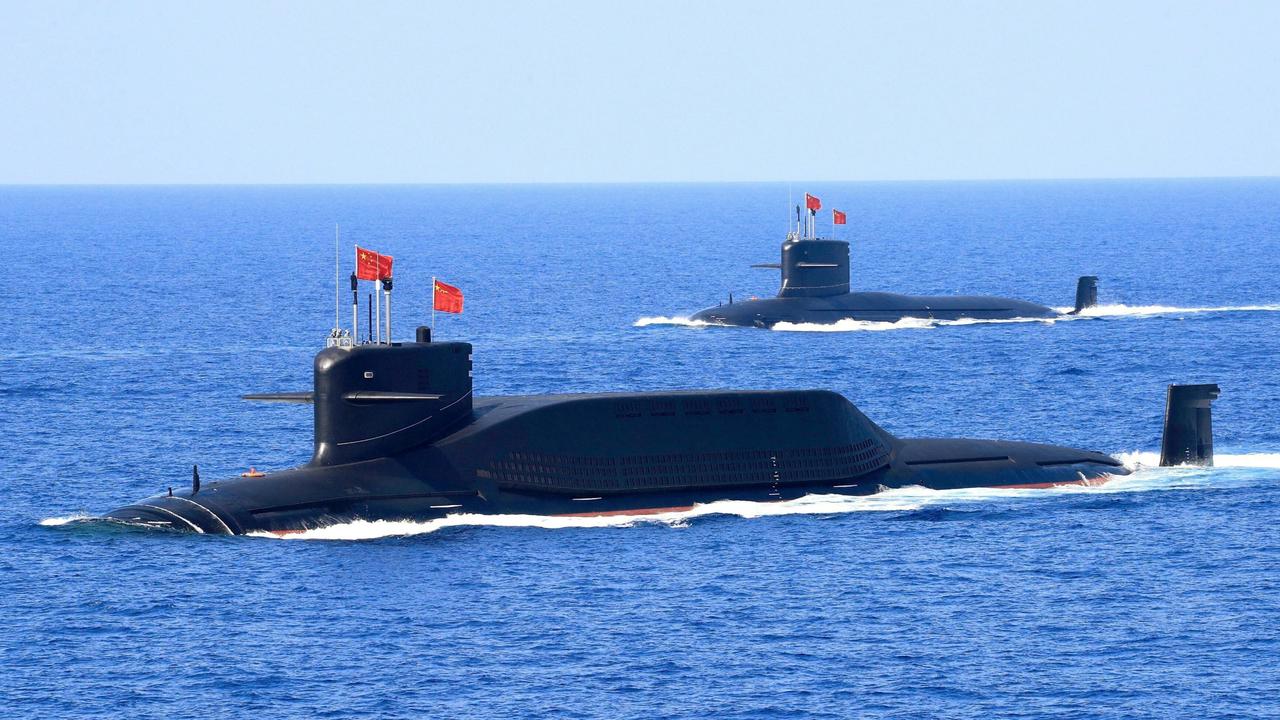China’s bizarre move to surface ICBM submarine in Taiwan Strait
China has done something that isn’t normally seen in war games – and the US has taken complete advantage of the opportunity.
Missile submarines are built to be secretive. They submerge to keep their nuclear arsenal safely out of sight. So when one parades itself on the surface, the world pays attention.
Military analyst H. I. Sutton this week highlighted the surface transit of a Chinese Intercontinental Ballistic Missile (ICBM) submarine through the Taiwan Strait.
Its presence was captured by the European Space Agency’s Sentinel-2 Earth observation satellite in a Monday, November 29, open-source image.
“Although Sentinel-2 is low resolution, the wake patterns are characteristic of a submarine with a typical rounded bow. The length best fits the Type 094, and the context aligns,” Sutton notes.
Mr Sutton points out that the submarine was probably on its way to a naval shipyard for repairs or upgrades.
But the timing seems somewhat coincidental.
The “boomer”, as ICBM missile-carrying submarines are called, may have been putting on an intimidation act for Taiwan.
It’s something Beijing has done before.
Maintenance or message?
At the height of a “reunification” crisis in 1996, when Taiwan held its first democratic presidential election, the People’s Liberation Army Navy (PLAN) surfaced a “boomer” in the Taiwan Strait. This was amid a series of high-profile war games and missile test firings designed to display Beijing’s displeasure at Taiwan’s act of self-determination.
On Monday, Taiwan was at it again.
A US parliamentarian visited Taipei at the weekend in defiance of Beijing’s demands that it has total jurisdiction over the island. China displayed its displeasure by sending 27 combat jets into the vicinity of Taiwan on Sunday.
A total of 27 #PLA aircraft intruded into our ADIZ today. The #PRC coercive action is obviously meant to bring #Taiwan to its knees & keep us away from democratic partners. But make no mistake: We'll never bow to #CCP pressure. Never, never, never! JW https://t.co/gMlZuZbVNw
— 外交部 Ministry of Foreign Affairs, ROC (Taiwan) 🇹🇼 (@MOFA_Taiwan) November 28, 2021
Taipei had also accepted an invitation to a Washington-initiated Summit for Democracy, called in response to China and Russia’s growing authoritarianism. And a delegation from Lithuania was also visiting Taipei in open defiance of Beijing’s wolf warrior diplomats and threats of economic coercion.
Such signs of independence rarely go without a display by Beijing of its ability to carry out “reunification by force”.
Breaking: USN P-8A #AE6832 flies through the Taiwan Strait, Nov 29. pic.twitter.com/QyStUBjbgV
— SCS Probing Initiative (@SCS_PI) November 29, 2021
And submarines are seldom seen unless they want to be seen. Submarines stay invisible for a reason.
There is much that can be learned from them when one knows where they are.
Their wakes can reveal much about the shape and performance of their hull. Distinctive sounds can be recorded and identified. And that’s along with more mundane details such as speed and surface stability.
In this case, the United States appears to have taken advantage of the opportunity to do just that.
Beijing University’s South China Sea Probing Initiative – which bypasses China’s strict bans on posting to Western social media – highlighted a surveillance overflight. A US Navy P-8A Poseidon submarine hunter passed over the length of the Taiwan Strait that same day.
Submarine arms race
Beijing has voiced extreme displeasure at Australia’s announcement of a technology-sharing deal with the US and UK to build “boomer” hunting nuclear-powered attack submarines.
But it’s been busily building up its own force.
China first deployed the Type 094 “Jin” class in 2010. It’s a large, nuclear-powered vessel intended to carry 12 JL-2 ballistic missiles fitted with nuclear warheads.
While China has built “boomers” before, this class is the first to be regarded as a success.
Beijing has six ballistic missile-carrying submarines.

It also operates about six nuclear-powered attack submarines and 50 diesel-electric attack submarines.
“This is where the fight is … where the competition is,” then-commander of the US 2nd Fleet, Vice Admiral Andrew Lewis, said late last year. “Anti-submarine warfare is a primary mission for everybody in the United States Navy, regardless of what you wear on your chest.”
Submarine technology is regarded as one of the last areas in which the West retains an advantage. Beijing has attempted to counterbalance this through sheer numbers. And the Pentagon suspects the artificial island fortresses it has built in the South China Sea are intended to make the waterway a safe bastion for them.
A recent Pentagon report highlights the suspected ability of a new class of “boomer” to fire a new type of ballistic missile at the US from this region.
“Type 096 SSBN reportedly will be armed with a follow-on SLBM (submarine-launched ballistic missile), and it will likely begin construction in the early-2020s,” the report reads. “The current range limitations of the JL-2 (SLBM) will require the Jin to operate in areas north and east of Hawaii if the PRC seeks to target the east coast of the United States.”
The new Type 096 is expected to enter service in 2025.
Jamie Seidel is a freelance writer | @JamieSeidel






